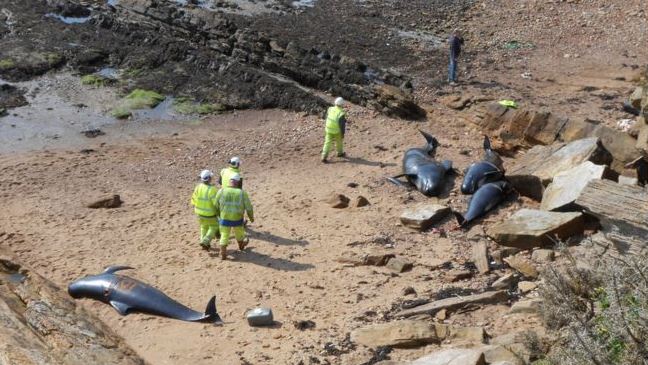Stranded long-finned pilot whales had toxic levels of mercury in their bodies, scientists from the University of Aberdeen and the Scottish Marine Animal Stranding Scheme found. They had examined a pod of whales that were stranded and died in Fife in 2012. Some toxic chemicals, they said, had reached the animals’ brains and would have caused severe neurological damage in humans.
Members of a pod of whales under investigation were stuck on a beach between Pittenweem and Anstruther in Scotland on 12th September, 2012. Only ten of the thirty-one animals could be refloated – the remaining twenty-one (5 males and 16 females) died.
The findings and conclusions of this latest study have been published in the peer-reviewed academic journal Science of the Total Environment (citation below).
 A total of thirty-one whales were stranded in Fife, Scotland in 2012 on a beach. Despite heroic efforts by rescuers, only ten managed to make it back into deep water – the rest died. (Image: University of Aberdeen)
A total of thirty-one whales were stranded in Fife, Scotland in 2012 on a beach. Despite heroic efforts by rescuers, only ten managed to make it back into deep water – the rest died. (Image: University of Aberdeen)
Mercury levels toxic enough to cause ‘severe neurological damage in humans’ were found in the animals. They also reported that cadmium – a toxic element for humans and most animals – can cross the blood-brain barrier.
Higher concentrations of toxins in older whales
The scientists detected a clear correlation between levels of toxic metals in the whales’ systems and their age – older animals had higher concentrations than their younger counterparts, suggesting that these toxins accumulate in their bodies.
It is possible, the researchers say, that long-finned pilot whales are less susceptible to mercury poisoning than humans. However, they cannot rule out the possibility that it was a factor leading to their navigating off course and ending up stranded on the beach.
Dr. Eva Krupp, who works as an environmental analytical chemist at the University of Aberdeen, gathered and analyzed samples from the whales together with PhD students Zuzana Gajdosechova and Cornelius Brombach.
Dr. Krupp said:
“We were able to gather an unprecedented number of tissue samples from all the major organs including the brain and as a result we can see for the first time the long term effects of mammalian exposure to the environmental pollutants.”
“This pod of whales provides unique new insights because we were able to look at the effects on a large number of whales from the same pod and how this varied according to age.”
The age of the whales in their samples ranged from under 12 months to 36 years. They saw that the oldest ones had considerably higher levels of mercury, compared to the younger ones.
 One of the whales that died in Fife in 2012. If whales are as susceptible to mercury poisoning as we are, concentrations found in them would mean that they suffered severe neurological damage. Scientists don’t know how susceptible whales are.
One of the whales that died in Fife in 2012. If whales are as susceptible to mercury poisoning as we are, concentrations found in them would mean that they suffered severe neurological damage. Scientists don’t know how susceptible whales are.
Older whales with mercury in their brains
All the whales aged nine years or more had very high concentrations of mercury in their brains. In three of them, the concentrations were high enough to cause severe neurological damage in humans.
Dr. Krupp added:
“We can see clear evidence that mercury is being transported through the blood stream to all organs where it accumulates over the lifespan. As well as an increased concentration of mercury in the brain as the whales become older, we see a similar effect with cadmium, which has not been previously reported.”
“It is known that cadmium can penetrate the blood brain barrier in the new-born or developmental stages but it was not thought to do so in adults Our findings are significant because we can demonstrate for the first time that cadmium is in the brain tissue and that its levels increase with age.”
“Although the body has a natural defence mechanism in the form of the element selenium, which detoxifies these harmful chemicals, we found that the majority of selenium is not available for the synthesis of essential proteins in older animals. This indicates that the longer mammals live, the less able they may be to cope with the toxic effects.”
Mercury levels in our oceans
Since the industrial revolution, mercury concentrations in our oceans have increased dramatically, previous studies have shown. Consequently, marine animals today have much higher levels of the toxic metal than before.
 The long-finned pilot whale (Globicephala melas) is a large species of oceanic dolphin. They are found in the North Atlantic as well as the Southern Hemisphere. In the North Atlantic they have been observed off the coasts of the Azores and the Faroe Islands, as well as down the western coast of Europe all the way to North Africa. (Image: Wikipedia)
The long-finned pilot whale (Globicephala melas) is a large species of oceanic dolphin. They are found in the North Atlantic as well as the Southern Hemisphere. In the North Atlantic they have been observed off the coasts of the Azores and the Faroe Islands, as well as down the western coast of Europe all the way to North Africa. (Image: Wikipedia)
Regarding mercury, cadmium and whales’ ability to navigate, Dr. Krupp said:
“So far, we have no indication that the mercury and cadmium levels in the brain cause disorientation, which in some cases can lead to strandings, but there is a potential for higher stress in these iconic animals due to rising toxic metal concentration in the oceans.”
“More research is needed to investigate whether this is a factor in strandings, particularly where other explanations such as illness or weather events cannot be found.”
According to the World Health Organisation, high levels of mercury in the human body can cause tremors, memory loss, headaches, motor dysfunction (can’t move properly), cognitive dysfunction (can’t think properly), insomnia, and neuromuscular effects. Kidney effects have also been reported, ranging from higher protein concentrations in the urine to kidney failure.
We do not know what the effects of high concentrations of mercury in whales are.
In an Abstract in the journal, the authors wrote:
“High concentrations of Hg (mercury) and Cd (cadmium) in the tissues of pilot whales presented in this study reflect ever increasing toxic stress on marine mammals.”
Citation: “Possible link between Hg and Cd accumulation in the brain of long-finned pilot whales (Globicephala melas),” Jörg Feldmann, Eva M. Krupp, Zuzana Gajdosechova, Andrew Brownlow, Nicolas T. Cottin, Fiona L. Read, Mariana Fernandes, Dagmar S. Urgast & Andrea Raab. Science of The Total Environment, Volumes 545–546, 1 March 2016, Pages 407–413. DOI: 10.1016/j.scitotenv.2015.12.082.
Video – Pilot whale strandings happen globally
Pilot whale strandings have been reported in several countries. In 2014, thirty-nine got stuck on a beach in New Zealand and died.
